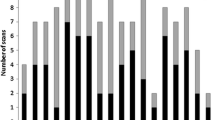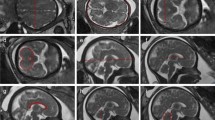Abstract
Purpose
Abnormal fetal brain measurements might affect clinical management and parental counseling. The effect of between-field-strength differences was not evaluated in quantitative fetal brain imaging until now. Our study aimed to compare fetal brain biometry measurements in 3.0 T with 1.5 T scanners.
Methods
A retrospective cohort of 1150 low-risk fetuses scanned between 2012 and 2021, with apparently normal brain anatomy, were retrospectively evaluated for biometric measurements. The cohort included 1.5 T (442 fetuses) and 3.0 T scans (708 fetuses) of populations with comparable characteristics in the same tertiary medical center. Manually measured biometry included bi-parietal, fronto-occipital and trans-cerebellar diameters, length of the corpus-callosum, vermis height, and width. Measurements were then converted to centiles based on previously reported biometric reference charts. The 1.5 T centiles were compared with the 3.0 T centiles.
Results
No significant differences between centiles of bi-parietal diameter, trans-cerebellar diameter, or length of the corpus callosum between 1.5 T and 3.0 T scanners were found. Small absolute differences were found in the vermis height, with higher centiles in the 3.0 T, compared to the 1.5 T scanner (54.6th-centile, vs. 39.0th-centile, p < 0.001); less significant differences were found in vermis width centiles (46.9th-centile vs. 37.5th-centile, p = 0.03). Fronto-occipital diameter was higher in 1.5 T than in the 3.0 T scanner (66.0th-centile vs. 61.8th-centile, p = 0.02).
Conclusions
The increasing use of 3.0 T MRI for fetal imaging poses a potential bias when using 1.5 T-based charts. We elucidate those biometric measurements are comparable, with relatively small between-field-strength differences, when using manual biometric measurements. Small inter-magnet differences can be related to higher spatial resolution with 3 T scanners and may be substantial when evaluating small brain structures, such as the vermis.





Similar content being viewed by others
Abbreviations
- BPD:
-
Bi-parietal diameter
- CC:
-
Corpus callosum
- CSF:
-
Cerebro-spinal fluid
- TE:
-
Echo time
- fbMRI:
-
Fetal brain MRI
- BPD:
-
Bi-parietal diameter
- CC:
-
Corpus callosum
- CSF:
-
Cerebro-spinal fluid
- TE:
-
Echo time
- fbMRI:
-
Fetal brain MRI
- FOV:
-
Field-of-view
- FOD:
-
Fronto-occipital diameter
- GA:
-
Gestational age
- MRI:
-
Magnetic resonance imaging
- TR:
-
Repetition time
- SD:
-
Standard deviation
- TCD:
-
Trans-cerebellar diameter
References
Victoria T, Johnson AM, Edgar JC, Zarnow DM, Vossough A, Jaramillo D (2016) Comparison between 1.5-T and 3-T MRI for fetal imaging: is there an advantage to imaging with a higher field strength? AJR Am J Roentgenol 206:195–201
Chapman T, Alazraki AL, Eklund MJ (2018) A survey of pediatric diagnostic radiologists in North America: current practices in fetal magnetic resonance imaging. Pediatr Radiol 48:1924–1935
Chartier AL, Bouvier MJ, McPherson DR, Stepenosky JE, Taysom DA, Marks RM (2019) The safety of maternal and fetal MRI at 3 T. AJR Am J Roentgenol 213:1170–1173
Jaimes C, Delgado J, Cunnane MB, Hedrick HL, Adzick NS, Gee MS, Victoria T (2019) Does 3-T fetal MRI induce adverse acoustic effects in the neonate? A preliminary study comparing postnatal auditory test performance of fetuses scanned at 1.5 and 3 T. Pediatr Radiol 49:37–45
Kyriakopoulou V, Vatansever D, Davidson A, Patkee P, Elkommos S, Chew A, Martinez-Biarge M, Hagberg B, Damodaram M, Allsop J, Fox M, Hajnal JV, Rutherford MA (2017) Normative biometry of the fetal brain using magnetic resonance imaging. Brain Struct Funct 222:2295–2307
Tilea B, Alberti C, Adamsbaum C, Armoogum P, Oury JF, Cabrol D, Sebag G, Kalifa G, Garel C (2009) Cerebral biometry in fetal magnetic resonance imaging: new reference data. Ultrasound Obstet Gynecol 33:173–181
Buchanan CR, Munoz Maniega S, Valdes Hernandez MC, Ballerini L, Barclay G, Taylor AM, Russ TC, Tucker-Drob EM, Wardlaw JM, Deary IJ, Bastin ME, Cox SR (2021) Comparison of structural MRI brain measures between 1.5 and 3 T: data from the Lothian Birth Cohort 1936. Hum Brain Mapp 42:3905–3921
Chu R, Tauhid S, Glanz BI, Healy BC, Kim G, Oommen VV, Khalid F, Neema M, Bakshi R (2016) Whole brain volume measured from 1.5T versus 3T MRI in healthy subjects and patients with multiple sclerosis. J Neuroimaging 26:62–67
Heinen R, Bouvy WH, Mendrik AM, Viergever MA, Biessels GJ, de Bresser J (2016) Robustness of automated methods for brain volume measurements across different MRI field strengths. PLoS ONE 11:e0165719
Kiserud T, Benachi A, Hecher K, Perez RG, Carvalho J, Piaggio G, Platt LD (2018) The World Health Organization fetal growth charts: concept, findings, interpretation, and application. Am J Obstet Gynecol 218:S619–S629
Colleran GC, Kyncl M, Garel C, Cassart M (2022) Fetal magnetic resonance imaging at 3 Tesla - the European experience. Pediatr Radiol 52:959–970
Nagaraj UD, Calvo-Garcia MA, Merrow AC, Zhang B, Tkach JA, Kline-Fath BM (2021) Utilization of 3-T fetal magnetic resonance imaging in clinical practice: a single-institution experience. Pediatr Radiol 51:1798–1808
Priego G, Barrowman NJ, Hurteau-Miller J, Miller E (2017) Does 3T fetal MRI improve image resolution of normal brain structures between 20 and 24 weeks’ gestational age? AJNR Am J Neuroradiol 38:1636–1642
Tarui T, Limperopoulos C, Sullivan NR, Robertson RL, du Plessis AJ (2014) Long-term developmental outcome of children with a fetal diagnosis of isolated inferior vermian hypoplasia. Arch Dis Child Fetal Neonatal Ed 99:F54-58
Khawam M, de Dumast P, Deman P, Kebiri H, Yu T, Tourbier S, Lajous H, Hagmann P, Maeder P, Thiran JP, Meuli R, Dunet V, Bach Cuadra M, Koob M (2021) Fetal brain biometric measurements on 3D super-resolution reconstructed T2-weighted MRI: an intra- and inter-observer agreement study. Front Pediatr 9:639746
Matthew J, Malamateniou C, Knight CL, Baruteau KP, Fletcher T, Davidson A, McCabe L, Pasupathy D, Rutherford M (2018) A comparison of ultrasound with magnetic resonance imaging in the assessment of fetal biometry and weight in the second trimester of pregnancy: an observer agreement and variability study. Ultrasound 26:229–244
Ioannou C, Talbot K, Ohuma E, Sarris I, Villar J, Conde-Agudelo A, Papageorghiou AT (2012) Systematic review of methodology used in ultrasound studies aimed at creating charts of fetal size. BJOG 119:1425–1439
Di Mascio D, Khalil A, Rizzo G, Kasprian G, Caulo M, Manganaro L, Odibo AO, Flacco ME, Giancotti A, Buca D, Liberati M, Timor-Tritsch IE, D’Antonio F (2022) Reference ranges for fetal brain structures using magnetic resonance imaging: systematic review. Ultrasound Obstet Gynecol 59:296–303
Keihaninejad S, Heckemann RA, Fagiolo G, Symms MR, Hajnal JV, Hammers A, Alzheimer’s disease neuroimaging I (2010) A robust method to estimate the intracranial volume across MRI field strengths (1.5T and 3T). Neuroimage 50:1427–1437
Chu R, Hurwitz S, Tauhid S, Bakshi R (2017) Automated segmentation of cerebral deep gray matter from MRI scans: effect of field strength on sensitivity and reliability. BMC Neurol 17:172
Ren JY, Zhu M, Wang G, Gui Y, Jiang F, Dong SZ (2022) Quantification of intracranial structures volume in fetuses using 3-D volumetric MRI: normal values at 19 to 37 weeks’ gestation. Front Neurosci 16:886083
Makropoulos A, Counsell SJ, Rueckert D (2018) A review on automatic fetal and neonatal brain MRI segmentation. Neuroimage 170:231–248
Gholipour A, Rollins CK, Velasco-Annis C, Ouaalam A, Akhondi-Asl A, Afacan O, Ortinau CM, Clancy S, Limperopoulos C, Yang E, Estroff JA, Warfield SK (2017) A normative spatiotemporal MRI atlas of the fetal brain for automatic segmentation and analysis of early brain growth. Sci Rep 7:476
Peterson BS, Anderson AW, Ehrenkranz R, Staib LH, Tageldin M, Colson E, Gore JC, Duncan CC, Makuch R, Ment LR (2003) Regional brain volumes and their later neurodevelopmental correlates in term and preterm infants. Pediatrics 111:939–948
Thompson DK, Wood SJ, Doyle LW, Warfield SK, Lodygensky GA, Anderson PJ, Egan GF, Inder TE (2008) Neonate hippocampal volumes: prematurity, perinatal predictors, and 2-year outcome. Ann Neurol 63:642–651
Sadhwani A, Wypij D, Rofeberg V, Gholipour A, Mittleman M, Rohde J, Velasco-Annis C, Calderon J, Friedman KG, Tworetzky W, Grant PE, Soul JS, Warfield SK, Newburger JW, Ortinau CM, Rollins CK (2022) Fetal brain volume predicts neurodevelopment in congenital heart disease. Circulation 145:1108–1119
Shi Y, Xue Y, Chen C, Lin K, Zhou Z (2020) Association of gestational age with MRI-based biometrics of brain development in fetuses. BMC Med Imaging 20:125
Griffiths PD, Bradburn M, Campbell MJ, Cooper CL, Graham R, Jarvis D, Kilby MD, Mason G, Mooney C, Robson SC, Wailoo A, group Mc (2017) Use of MRI in the diagnosis of fetal brain abnormalities in utero (MERIDIAN): a multicentre, prospective cohort study. Lancet 389:538–546
Leung TN, Pang MW, Daljit SS, Leung TY, Poon CF, Wong SM, Lau TK (2008) Fetal biometry in ethnic Chinese: biparietal diameter, head circumference, abdominal circumference and femur length. Ultrasound Obstet Gynecol 31:321–327
Jacquemyn Y, Sys SU, Verdonk P (2000) Fetal biometry in different ethnic groups. Early Hum Dev 57:1–13
Funding
No funding was received for this study.
Author information
Authors and Affiliations
Contributions
Guarantor of integrity of the entire study — Chen Hoffmann and Shai Shrot; study concepts and design — Shai Shrot; literature research — Shai Shrot; clinical studies — N/A; experimental studies/data analysis — Yiftach Barash and Shai Shrot; statistical analysis — Shai Shrot; manuscript preparation — Shai Shrot and Efrat Hadi; manuscript editing — Shai Shrot, Efrat Hadi, and Chen Hoffmann.
Corresponding author
Ethics declarations
Conflict of interest
The authors declare no conflict of interest.
Ethical approval
The study was approved by the institutional research committee.
Informed consent
The institutional research committee approved a waiver for informed consent.
Additional information
Publisher's Note
Springer Nature remains neutral with regard to jurisdictional claims in published maps and institutional affiliations.
Supplementary Information
Below is the link to the electronic supplementary material.
Rights and permissions
Springer Nature or its licensor (e.g. a society or other partner) holds exclusive rights to this article under a publishing agreement with the author(s) or other rightsholder(s); author self-archiving of the accepted manuscript version of this article is solely governed by the terms of such publishing agreement and applicable law.
About this article
Cite this article
Shrot, S., Hadi, E., Barash, Y. et al. Effect of magnet strength on fetal brain biometry — a single-center retrospective MRI-based cohort study. Neuroradiology 65, 1517–1525 (2023). https://doi.org/10.1007/s00234-023-03193-y
Received:
Accepted:
Published:
Issue Date:
DOI: https://doi.org/10.1007/s00234-023-03193-y




